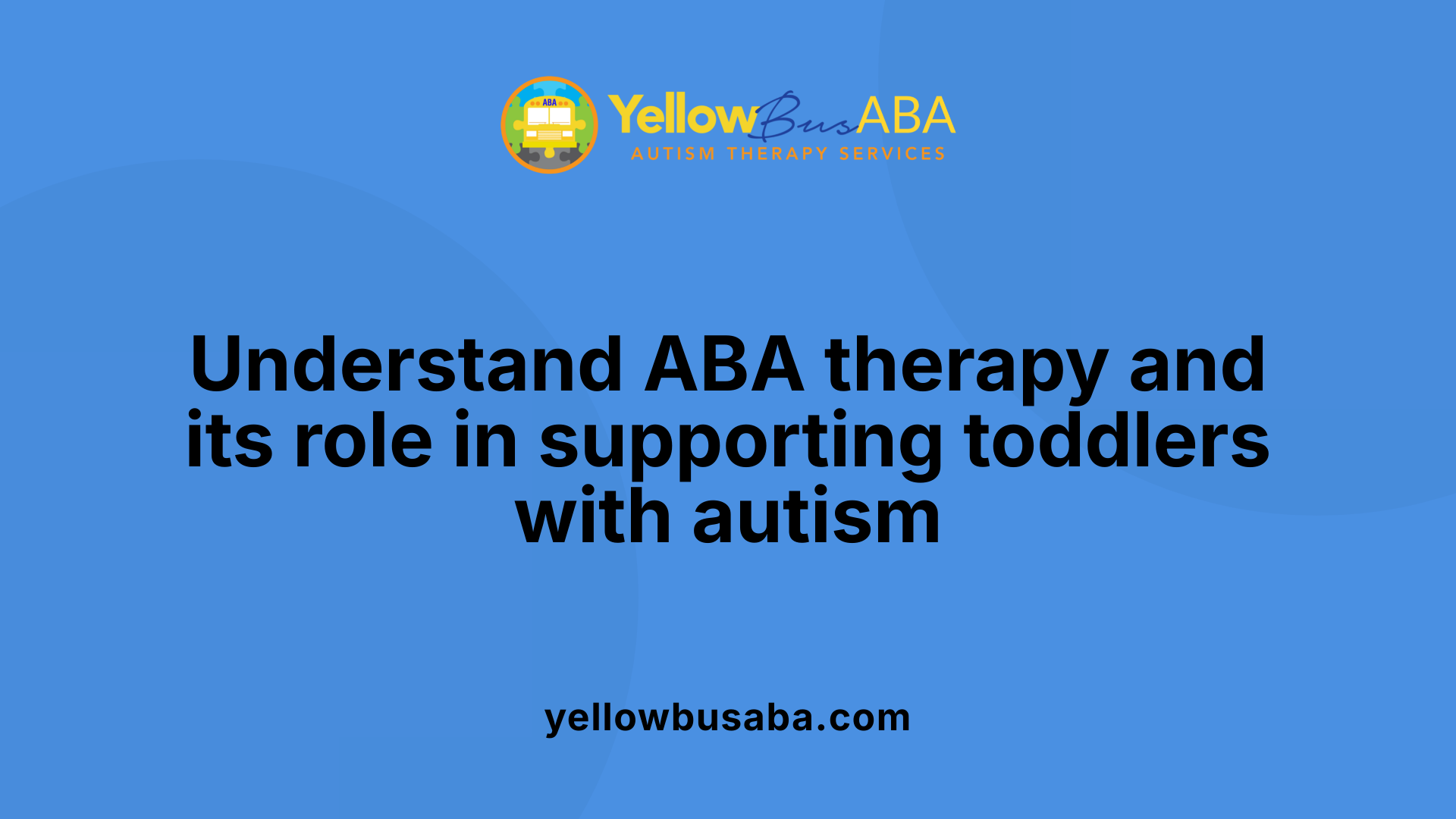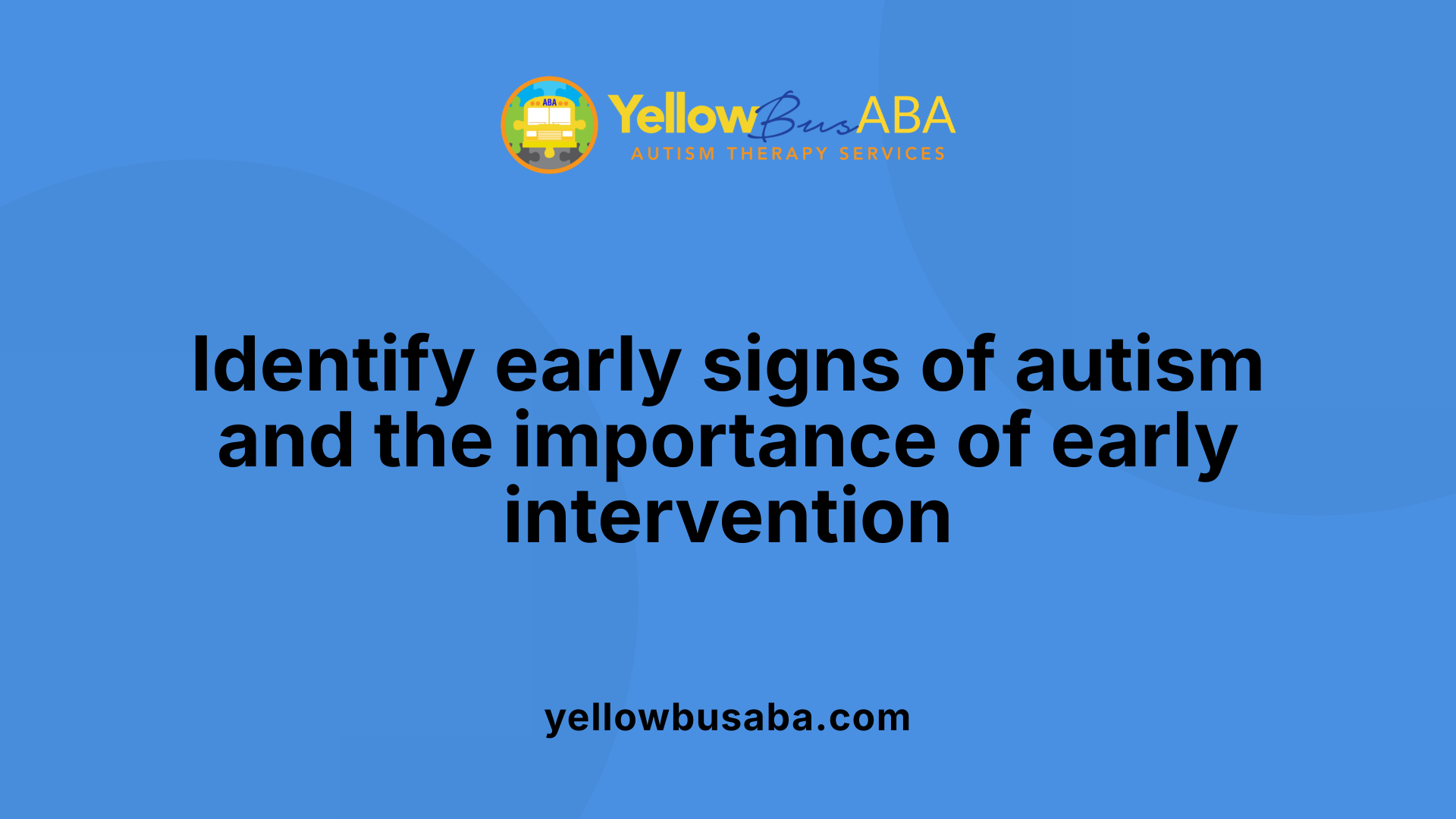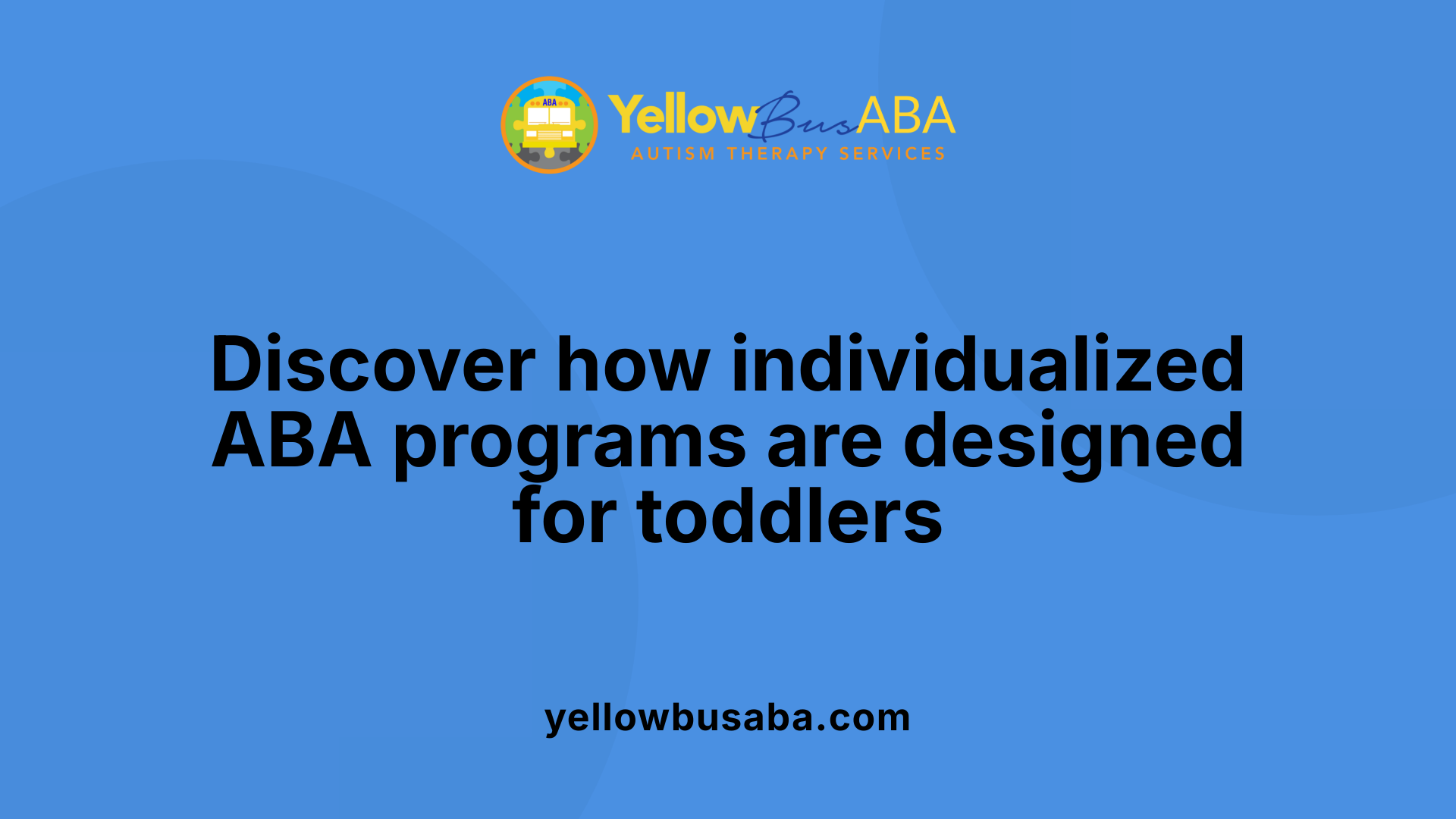Why Early Intervention Matters
Applied Behavior Analysis (ABA) therapy is a cornerstone approach for supporting toddlers diagnosed with autism spectrum disorder (ASD). Early intervention, especially before the age of five and sometimes as early as 18 months, can profoundly influence a child's developmental trajectory. Recognizing early signs of autism and initiating ABA therapy can improve communication, social skills, and adaptive behaviors, setting the stage for meaningful long-term progress.
What is ABA Therapy and How Does It Support Toddlers with Autism?

What is Applied Behavior Analysis (ABA) therapy and how is it used to support individuals with autism?
Applied Behavior Analysis (ABA) therapy is an evidence-based approach that helps children with autism spectrum disorder (ASD) improve important skills and reduce behaviors that interfere with daily life. It focuses on increasing communication, social abilities, and daily living skills through scientific principles of learning and behavior.
How is ABA therapy tailored to each child?
Before starting therapy, a comprehensive assessment identifies a child's strengths and needs. This allows behavior analysts to set clear, measurable goals that are personalized for each child. Progress is carefully monitored and the treatment plan is adjusted over time.
What techniques are commonly used in ABA therapy?
ABA uses positive reinforcement to encourage helpful behaviors. Two core teaching methods are:
- Discrete Trial Training (DTT): Structured sessions where skills are broken down into small steps and taught at a table with clear instructions and rewards.
- Natural Environment Teaching (NET): Child-led learning in natural settings, promoting skills during everyday activities through play and interaction.
What skills does ABA therapy aim to improve?
Therapists work on skills like communication, social interaction (e.g., turn-taking, sharing), and daily living tasks such as toileting and hygiene. Additionally, ABA helps reduce repetitive behaviors and challenges, making it easier for children to adapt to routines.
Why is early intervention important?
Starting ABA therapy early, sometimes as young as 18 months, supports meaningful developmental gains and can improve a child's ability to function in normal classroom settings. A play-based, fun approach ensures toddlers remain engaged and motivated throughout therapy.
Recognizing Early Signs and Starting ABA Therapy

What are the key early signs of autism in toddlers?
Early signs of autism spectrum disorder (ASD) in toddlers may include avoiding eye contact, difficulty understanding social cues, delayed speech development, lack of interest in interacting with peers, and intense focus on specific objects. Recognizing these signs can help caregivers understand when a child might benefit from specialized support.
Why is early recognition and diagnosis important?
Early recognition and diagnosis of developmental challenges are crucial for meaningful progress. When developmental delays in communication and social skills are identified promptly, children can start targeted interventions sooner. Early behavioral interventions, such as ABA therapy initiated before age five—sometimes as early as 18 months—have been shown to improve communication, social interactions, and cognitive development significantly.
How do families access ABA therapy after diagnosis?
After obtaining a formal diagnosis of autism, a parent consultation with a Board Certified Behavior Analyst (BCBA) is recommended. Accessing ABA therapy typically involves several steps: recognizing early signs, obtaining a diagnosis, and then selecting a suitable intervention program. Families can seek support from non-profit organizations, government programs, and insurance providers to facilitate access to therapy services.
What role do comprehensive assessments play in shaping ABA therapy goals?
Before starting ABA therapy, comprehensive assessments identify a child’s strengths and areas of need across different developmental domains. These evaluations guide the setting of measurable goals, which may include reducing challenging behaviors and increasing communication and social skills. Assessments ensure that therapy is tailored to the unique needs of each child and that progress can be effectively monitored over time.
Who Provides ABA Therapy and Their Qualifications

Who Provides ABA Therapy and What Qualifications Do These Professionals Typically Have?
ABA therapy is typically provided by specialized professionals trained in Applied Behavior Analysis principles. The primary providers are Board Certified Behavior Analysts (BCBAs) and Registered Behavior Technicians (RBTs).
BCBAs hold graduate degrees in behavior analysis or related fields and have passed a rigorous certification process. This ensures they possess comprehensive knowledge of behavioral theories and intervention methods. BCBAs conduct assessments, design tailored therapy programs, and supervise treatment implementation to optimize outcomes.
RBTs usually have a high school diploma or equivalent and receive specialized training to deliver therapy under the close supervision of BCBAs. They work directly with the child during therapy sessions, implementing established treatment plans.
In addition, some speech-language pathologists and occupational therapists integrate ABA techniques into their interventions to support social communication and daily living skills.
The collaboration among these professionals, combined with their qualifications and expertise, ensures ABA therapy is individualized, effective, and delivered in a supportive manner tailored to each child’s unique strengths and needs.
Structuring and Personalizing ABA Programs for Toddlers

How is an ABA therapy program typically structured and personalized for an individual?
ABA therapy programs for toddlers start with a comprehensive assessment to identify each child's unique needs, strengths, and challenges across multiple developmental domains. This evaluation creates a foundational understanding essential for tailoring the intervention.
Following the assessment, measurable, individualized goals are set. These goals often focus on improving communication abilities, social skills like turn-taking and joint attention, and essential daily living skills such as toileting and food tolerance. The objectives also aim to reduce challenging behaviors that interfere with learning.
ABA therapy uses a blend of teaching methods to engage toddlers effectively. Discrete Trial Training (DTT) offers a structured approach conducted typically at a table, where skills are taught systematically with positive reinforcement. In contrast, Natural Environment Teaching (NET) occurs within child-led, natural settings—like playtime at home or visits to the park—making learning contextually meaningful and enjoyable.
Building rapport is fundamental to a successful program. ABA sessions are designed to be playful and fun, incorporating games and interactive activities to keep toddlers motivated. This approach ensures the child feels comfortable and eager to participate, which enhances learning.
Progress is carefully monitored through ongoing data collection and regular reviews. If a strategy isn't yielding expected improvements, therapists adapt techniques or goals to better support the child's growth.
Together, this structure offers a personalized roadmap where individualized goals, dynamic teaching methods, and joyful engagement work hand-in-hand to support toddlers with autism on their developmental journey.
Key Benefits and Early Progress Observed with ABA Therapy
What improvements does ABA therapy bring in communication, social interaction, and cognitive development?
ABA therapy is designed to foster meaningful progress in communication skills, social engagement, and cognitive abilities. Children receiving early ABA intervention often learn to speak and use language more effectively, improve understanding of social cues, and develop better problem-solving skills. These gains contribute to more meaningful interactions with peers and adults.
How does ABA therapy reduce challenging behaviors and help children adapt to daily routines?
One important benefit of ABA is its focus on reducing challenging behaviors that interfere with learning or social participation. Through positive reinforcement, structured teaching, and consistent routines, children become more comfortable with daily activities like eating, toileting, and transitions. This stability enhances their ability to engage in various environments with less distress.
In what ways does ABA help children participate successfully in typical classroom settings?
Early and intensive ABA can prepare children to tolerate and thrive within regular classroom environments. By building foundational social and communication skills, children become more capable of following instructions, interacting with classmates, and managing sensory or behavioral challenges, facilitating smoother inclusion and academic success.
How does ABA therapy positively impact family dynamics and caregiver stress?
Family involvement is emphasized throughout ABA interventions, promoting supportive home environments. As children develop new skills and reduce disruptive behaviors, caregivers often experience less stress and greater confidence in managing their child's needs. This improvement nurtures healthier family relationships and well-being.
What role do autism social skills groups play in ABA therapy?
Social skills groups provide practical opportunities for children to practice turn-taking, sharing, joint attention, and other important interpersonal behaviors in structured, supportive settings. These groups complement individual therapy by encouraging peer interactions and generalization of learned skills.
Why is early intensive intervention important?
Starting ABA therapy early—sometimes as young as 18 months—leverages children's developmental plasticity, leading to more significant and lasting progress. Intensive programs before the age of five have shown the most marked improvements, helping children build essential skills that form the basis for lifelong learning and independence.
| Benefit Area | Description | Outcome Examples |
|---|---|---|
| Communication | Enhanced language and understanding of social cues | Improved speech, better conversational skills |
| Reducing challenging behaviors | Use of positive reinforcement to promote adaptive behaviors | Fewer tantrums, easier transitions to routines |
| Classroom participation | Skills to manage sensory, behavioral, and social challenges | Successful inclusion in regular classroom settings |
| Family well-being | Involvement of family reduces caregiver stress and builds support | Improved family relationships, reduced burnout |
| Social skills groups | Practice in peer interaction skills | Better turn-taking, sharing, and joint attention |
| Early intensive intervention | Leverages brain plasticity for maximal early gains | Accelerated development of communication and cognition |
Environmental Settings and Family Involvement in Therapy

Where is ABA Therapy Provided?
ABA therapy is versatile and can be delivered in multiple settings such as homes, schools, and clinical environments. This adaptability ensures that therapy is practical and relevant across the various occasions where a child interacts and learns.
How Does Natural Environment Teaching Support Learning?
Natural Environment Teaching (NET) is a key technique within ABA that occurs in everyday settings. It is child-led and integrates learning into real-life interactions, making the experience enjoyable and meaningful. This approach helps children apply new skills directly to their daily lives.
Why is Family Involvement Important?
Active participation of family members significantly improves therapy outcomes. When families are involved, they can reinforce skills outside of formal sessions, creating continuity and enhancing progress. Family involvement also nurtures a supportive home atmosphere.
How Does Family Participation Reduce Caregiver Stress?
Engaging caregivers in therapy lowers their stress levels by equipping them with tools to assist their child effectively. Feeling empowered and informed boosts caregiver confidence and lessens anxiety related to managing developmental challenges.
How Are Play and Natural Interactions Used?
Therapists build rapport with children through pairing activities that are playful and enjoyable. This playful approach helps children stay motivated and receptive, making learning less intimidating and more engaging.
How Do Early Intervention Programs Help With Transitions?
Early intervention programs assist children in adapting more smoothly to routines and learning environments. This preparation reduces the stress associated with transitions, enabling children to handle changes in daily schedules with greater ease.
Looking Ahead: Measuring Meaningful Early Progress
Early progress in ABA therapy for toddlers with autism is marked by gains in communication, social engagement, and adaptive behaviors. Through personalized, evidence-based interventions led by qualified professionals and supported by families, children can achieve meaningful developmental breakthroughs that pave the way for future learning and independence. Recognizing signs early, accessing timely therapy, and fostering a nurturing environment collectively maximize the trajectory toward fuller participation in everyday life. Ongoing monitoring and flexible programming ensure interventions remain responsive to each child's evolving needs, making ABA therapy a vital foundation for a hopeful future.
References
- 5 Signs Your Child Could Benefit from ABA Therapy
- Early Behavioral Intervention for Autism
- What Does ABA Therapy For Toddlers Look Like - Blog
- Applied Behavior Analysis (ABA)
- Applied Behavior Analysis (ABA)
- Applied Behavior Analysis in Children and Youth with Autism ...
- Applied Behavior Analysis (ABA) for Children With Autism
- Applied Behavior Analysis (ABA)
- The Top 10 Reasons Children With Autism Deserve ABA
- Applied Behavior Analysis (ABA)






